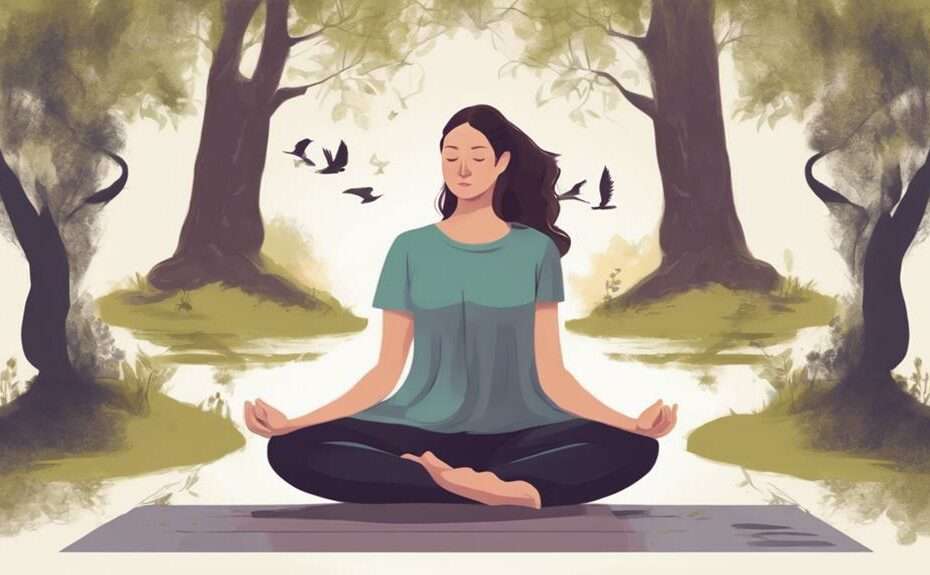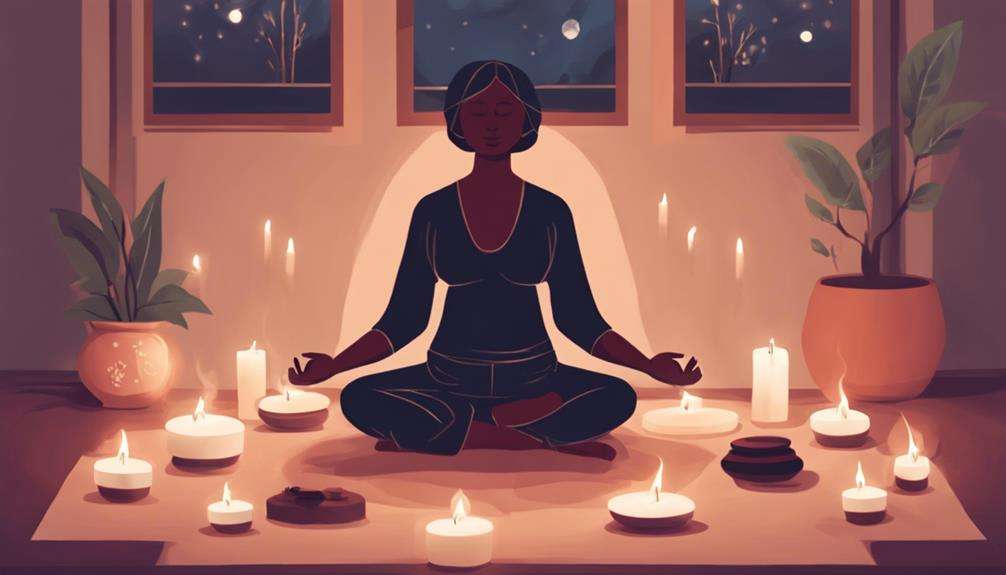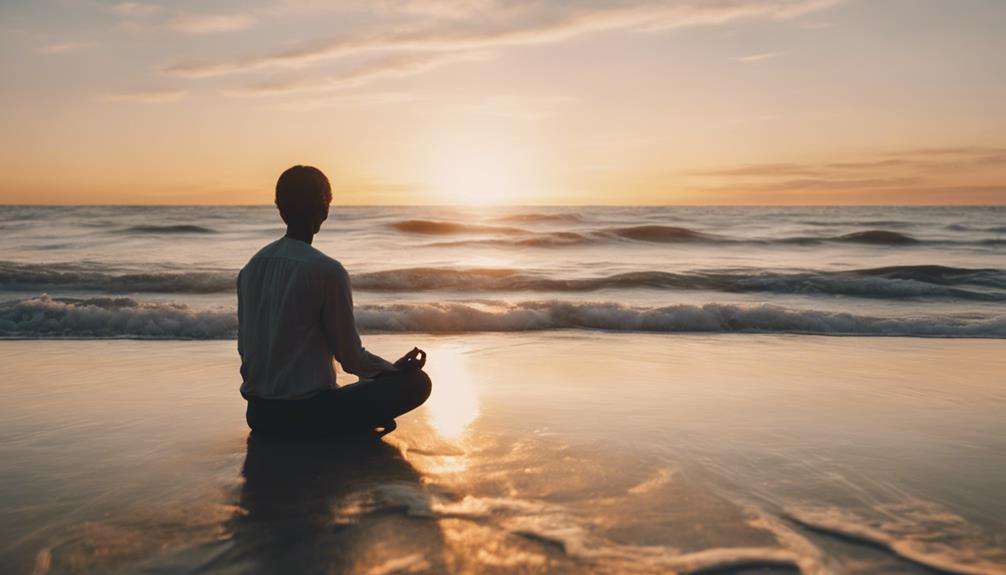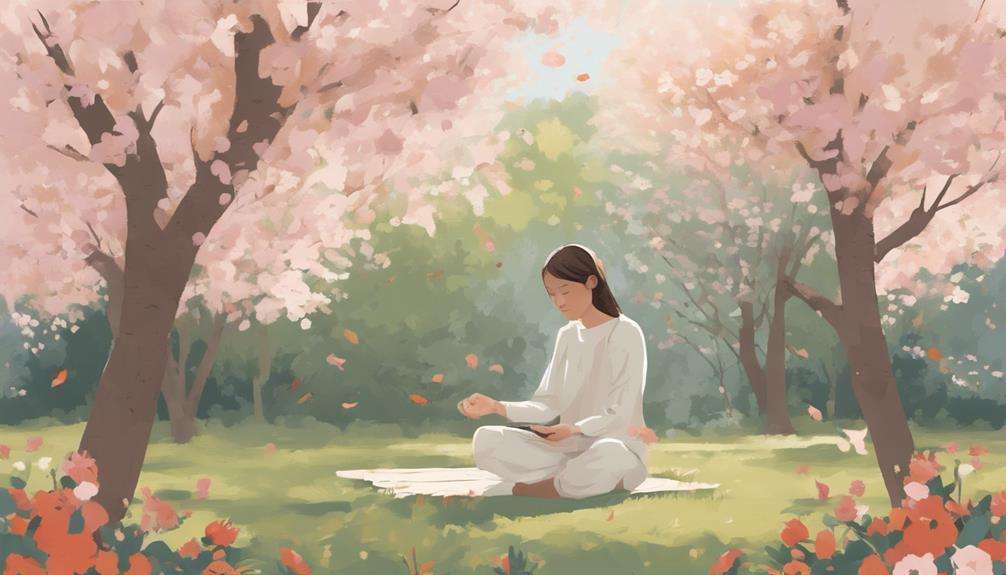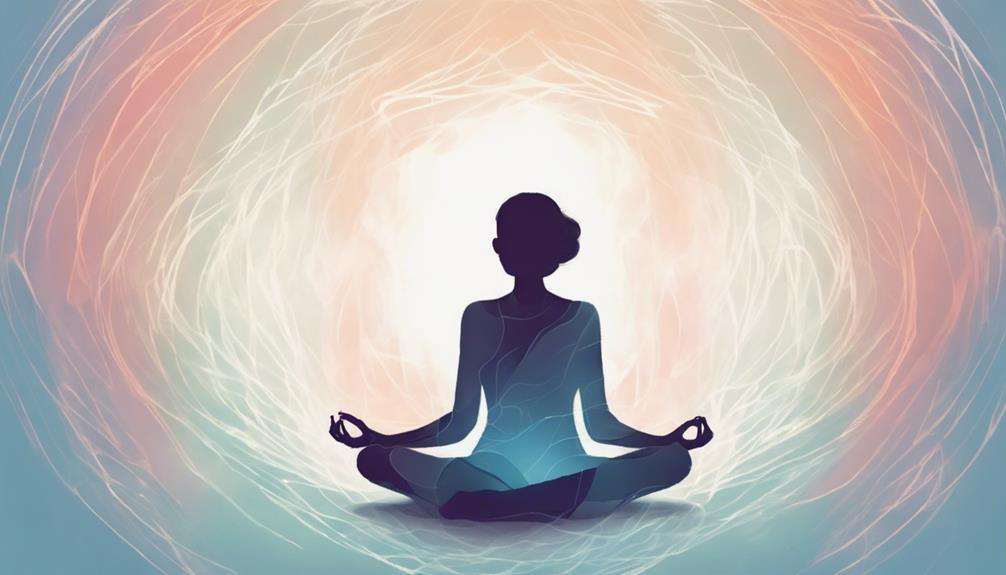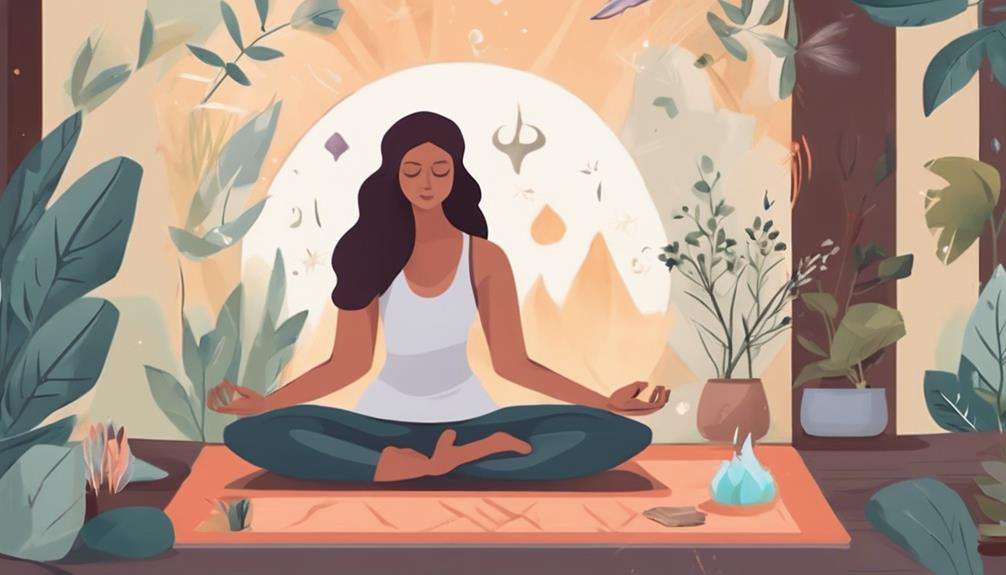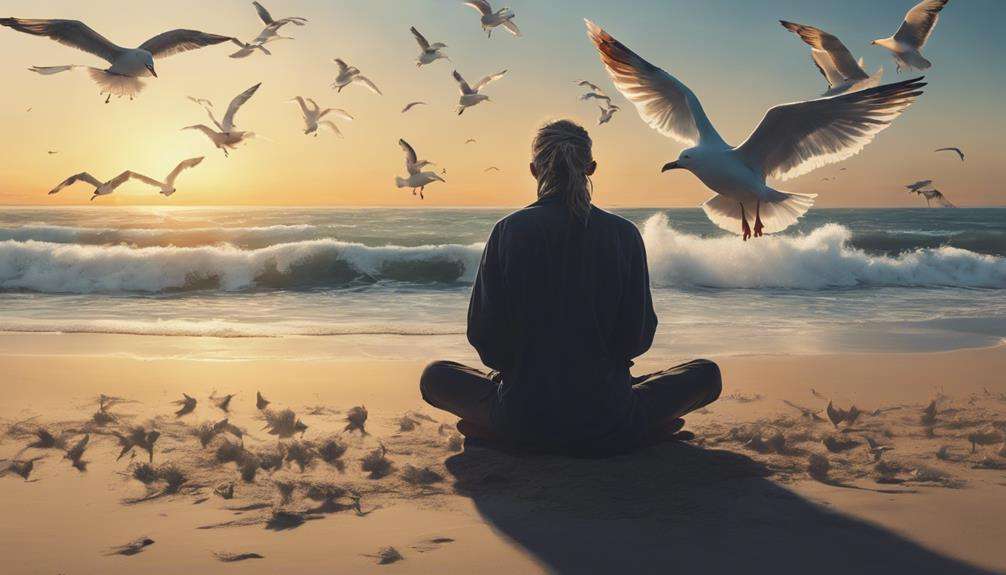Looking to ease your anxiety through simple yet effective practices? Imagine being able to find a moment of peace and tranquility amidst the chaos of daily life.
What if there were specific yoga poses that could help you achieve just that? These 10 poses are not only known for their calming effects but also for their ability to instill mindfulness and relaxation.
Discover how incorporating these poses into your routine can bring a sense of calm and balance to your mind and body, allowing you to navigate life with greater ease and clarity.
Key Takeaways
- Yoga poses like Seated Neck Stretch and Cat Pose relieve tension and enhance mobility for anxiety relief.
- Half Splits and Extended Puppy Pose aid in relaxation, flexibility, and mindfulness to calm anxiety.
- Proper form in poses like Half Splits ensures effective stretching and muscle engagement for anxiety reduction.
- Restorative poses like Supine Spinal Twist and Corpse Pose promote relaxation, stress relief, and emotional comfort for anxiety management.
Seated Neck Stretch
Experience relief from neck tension and stress with the Seated Neck Stretch yoga pose, a simple yet effective way to promote relaxation and flexibility. This gentle stretch targets the neck and shoulders, areas where tension commonly builds up, especially during times of stress. By incorporating the Seated Neck Stretch into your routine, you can alleviate tightness in these areas, improving your overall sense of well-being.
The Seated Neck Stretch is designed to release the tight muscles in your neck, allowing for greater mobility and reduced discomfort. As you perform this pose, you'll feel a gentle stretch along the sides and back of your neck, helping to relieve tension that may have accumulated throughout the day. By taking a few moments to breathe deeply and focus on this stretch, you can create a sense of calm and ease in both your body and mind.
Regular practice of the Seated Neck Stretch can have long-lasting benefits, contributing to a reduction in neck and shoulder tension over time. Incorporating this pose into your daily routine can't only help you find relief from immediate discomfort but also promote lasting relaxation and flexibility in these areas.
Cat Pose
Relieve tension in your spine and strengthen your back muscles with Cat Pose, also known as Marjaryasana, a yoga posture that promotes flexibility and relaxation. This pose involves arching your back while on all fours, which can help release tension in your back and neck, promoting a sense of ease.
Cat Pose is a common yoga pose used to warm up the spine and prepare your body for more challenging poses, making it a great addition to your yoga routine. By practicing Cat Pose, you can focus on your breath and mindful movements, which can help alleviate stress and anxiety.
Incorporating this pose into your regular yoga practice can enhance your overall mental well-being, fostering a sense of calmness and balance. So, next time you're feeling anxious, try incorporating Cat Pose into your practice to experience the relaxing benefits it offers.
Cow Pose
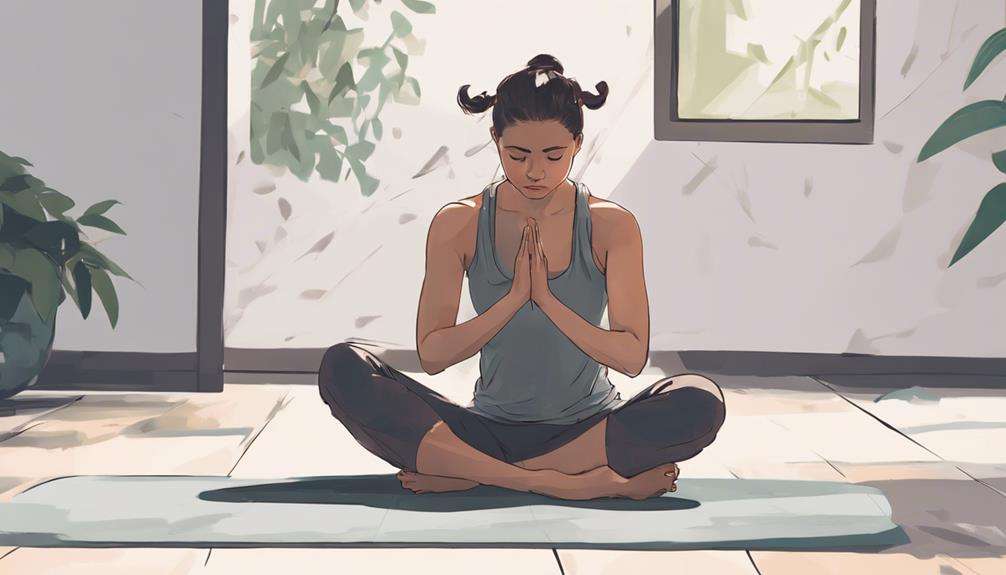
Cow Pose, also known as Bitilasana, improves spinal flexibility and posture while stimulating abdominal organs to promote digestion and relieve minor back pain. By practicing Cow Pose, you can gently stretch and lengthen your spine, helping to alleviate stiffness and enhance overall mobility.
This pose not only assists in maintaining a healthy back but also engages the core muscles, contributing to a stronger and more stable torso. The gentle arch created in Cow Pose can release tension in the back muscles, offering a sense of relief and relaxation.
Incorporating Cow Pose into your regular yoga routine can gradually increase your spine's flexibility and improve your posture over time. Remember to focus on your breath as you move into this pose, allowing the controlled inhalations and exhalations to deepen the stretch and enhance the benefits for your spinal health and overall well-being.
Extended Puppy Pose
To transition from the benefits of Cow Pose to the calming and grounding practice of Extended Puppy Pose, consider exploring a gentle yet effective yoga posture that combines elements of Child's Pose and Downward-Facing Dog. Extended Puppy Pose, also known as Uttana Shishosana, offers a soothing stretch for the spine and shoulders.
By gently elongating these areas, it helps release tension and promote relaxation in the upper body. This pose is especially beneficial for those looking to alleviate stress and anxiety. The mindful breathing encouraged in Extended Puppy Pose can aid in cultivating a sense of presence and calmness, allowing you to let go of worries and be in the moment.
Additionally, by opening the chest and heart space, this pose can facilitate emotional release and promote emotional healing. Regular practice of Extended Puppy Pose not only enhances flexibility in the spine and shoulders but also contributes to improved posture and overall well-being.
Try incorporating this pose into your routine to experience its grounding and stress-relieving benefits.
Half Splits
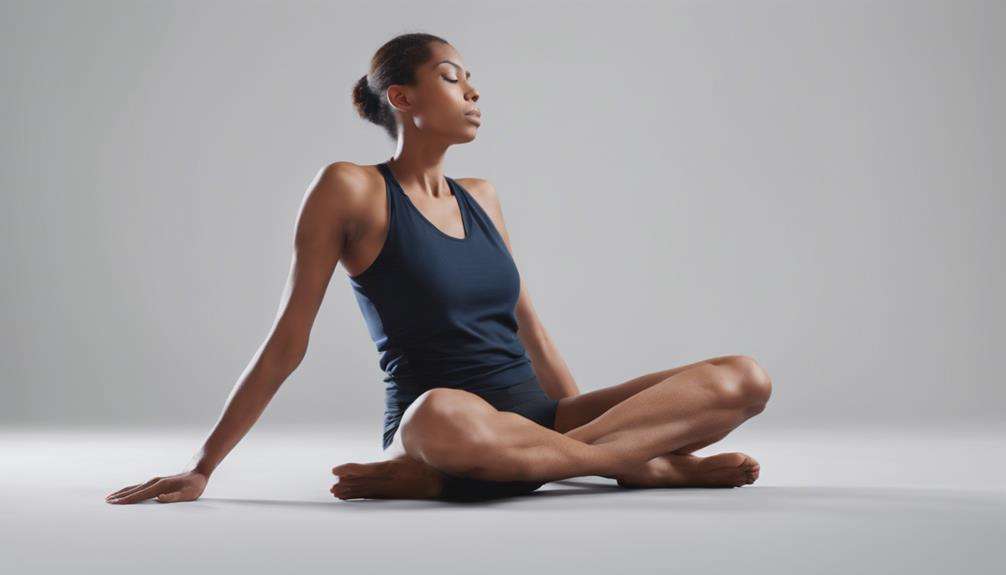
Are you ready to explore the benefits of Half Splits and learn about the proper form to maximize the advantages of this soothing yoga pose?
By practicing Half Splits, you can experience relief from tightness in your hamstrings and calves, leading to a sense of relaxation and ease.
Understanding the correct alignment and technique for Half Splits can help you reap the full benefits of this posture for calming anxiety and promoting mindfulness.
Benefits of Half Splits
Stretching your hamstrings and calves, the Half Splits pose (Ardha Hanumanasana) is a beneficial way to release tension and enhance flexibility. By targeting the hamstrings, this pose improves hip mobility, reducing tightness that can contribute to anxiety.
The grounding effect of Ardha Hanumanasana, by increasing blood flow to the legs, promotes stability that can calm the mind. Regular practice of Half Splits enhances body awareness, aiding in mindfulness and reducing anxiety.
The stretching and lengthening benefits of this pose not only release physical tension but also help alleviate emotional stress, making it a valuable posture for anxiety relief. Incorporating Half Splits into your routine can contribute to a sense of relaxation and overall well-being.
Proper Half Splits Form
For optimal form in the Half Splits pose, ensure the front knee is directly over the ankle as you start in a low lunge position. Here are some tips for maintaining proper form and maximizing the stretch:
- Front Knee Alignment: Keep the front knee stacked directly over the ankle to prevent strain and ensure a safe and effective stretch.
- Foot Flexion: Extend the front leg forward and flex the foot to engage the muscles and protect the knee joint during the stretch.
- Hip Square: Maintain square hips facing the front of the mat to deepen the stretch in the hamstrings and avoid twisting the pelvis.
- Spinal Alignment: Hinge at the hips and fold forward over the extended leg while keeping the spine long to avoid rounding the back and enhance the stretch.
Seated Forward Bend
Experience a soothing stretch that nurtures your body and calms your mind with the Seated Forward Bend pose, also known as Paschimottanasana. This gentle forward fold not only stretches your spine, shoulders, and hamstrings but also provides numerous mental health benefits. As you fold forward, focus on taking deep breaths to help release tension and anxiety. The Seated Forward Bend can specifically target the lower back, offering relief from any stiffness or discomfort in that area. By practicing this pose regularly, you can enhance flexibility in your lower back and improve digestion.
Furthermore, Paschimottanasana is known to stimulate the liver, kidneys, ovaries, and uterus, promoting overall health and well-being. This pose encourages relaxation and can help you find a sense of inner peace. So, next time you need to unwind and calm your mind, consider incorporating the Seated Forward Bend into your mindfulness routine.
Constructive Rest
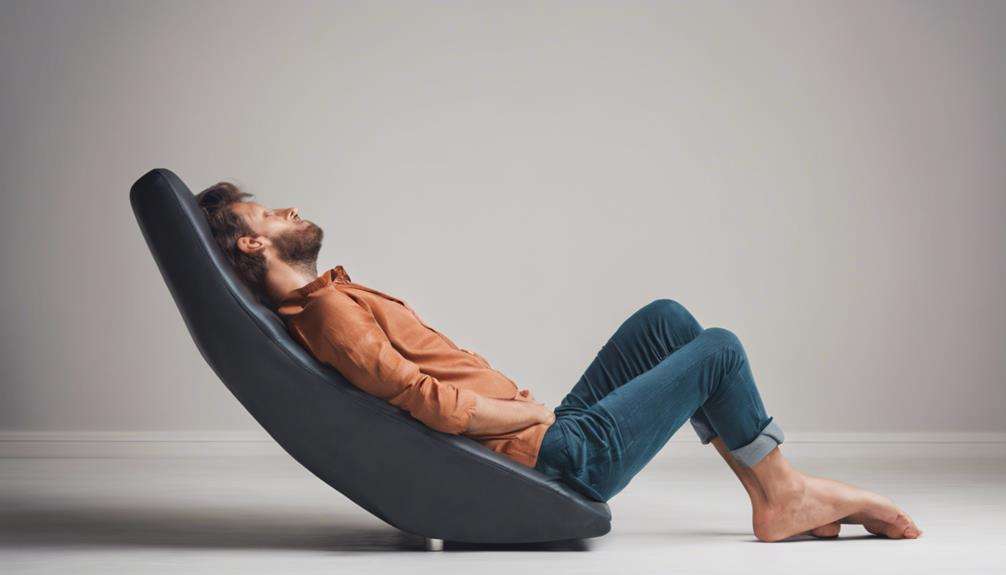
To transition from the Seated Forward Bend and further enhance relaxation and stress relief, consider practicing Constructive Rest, a restorative yoga pose known for promoting deep relaxation and relieving tension in both body and mind. This pose involves lying on your back with your knees bent and feet flat on the floor, allowing your spine to decompress and your body to release tension.
Here's why Constructive Rest can be beneficial for you:
- Promotes Relaxation: By allowing your body to rest in a supported position, Constructive Rest helps induce a state of deep relaxation, easing both physical and mental tension.
- Stress Relief: This pose aids in calming the nervous system, reducing stress levels, and providing a moment of respite from the demands of daily life.
- Anxiety Relief: Practicing Constructive Rest regularly can help alleviate anxiety symptoms, promoting a sense of calm and inner peace.
- Enhances Well-Being: By fostering mindfulness and body awareness, this pose contributes to emotional balance and overall well-being, making it a valuable tool for managing anxiety.
Supine Spinal Twist
When practicing the Supine Spinal Twist, you can experience relief from tension in your spine and lower back, promoting relaxation and reducing anxiety.
This pose aids in improving spinal mobility while gently twisting your torso to release stress.
Benefits of Supine Twist
Enhance your spinal health and promote relaxation with the Supine Twist pose, also known as Supine Spinal Twist. This gentle yoga posture offers various benefits that can help alleviate anxiety and improve your overall well-being. Here are some advantages of practicing the Supine Twist:
- Release Tension: By twisting the spine, this pose helps release tension in the spine and lower back, reducing discomfort.
- Promote Relaxation: Increasing flexibility in the spine, hips, and shoulders promotes relaxation, aiding in anxiety relief.
- Stimulate Digestion: The twist stimulates digestion and improves circulation, contributing to your overall health.
- Calm the Nervous System: Gentle twisting of the spine calms the nervous system and quiets the mind, beneficial for anxiety relief.
How to Practice
Ease into the practice of the Supine Spinal Twist by lying on your back and gently twisting your spine to release tension. This calming yoga pose is an effective way to find anxiety relief and promote mindfulness.
As you twist, focus on your breath and the sensations in your body, allowing yourself to let go of any stress or worries. The Spinal Twist stretches your back muscles, hips, and shoulders, aiding in relaxation and flexibility.
Incorporating this pose into your routine can help alleviate lower back discomfort and enhance your overall sense of calmness. Remember to listen to your body and only twist as far as feels comfortable, respecting your limits while still reaping the benefits of this soothing practice.
Corpse Pose (Savasana)
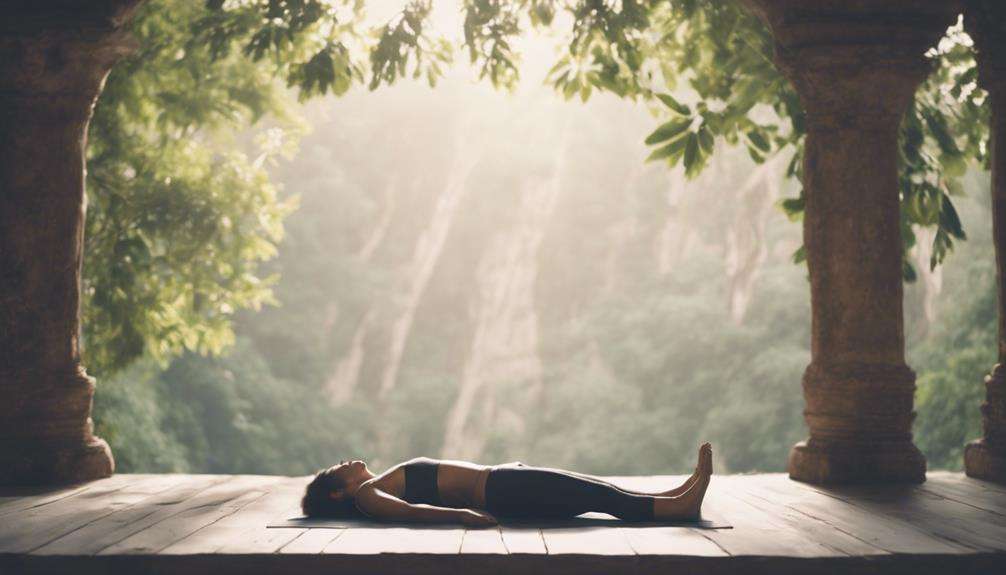
In yoga practice, find solace and rejuvenation in the restorative and comforting posture known as Corpse Pose (Savasana). This pose is grounding and supportive, providing a sense of emotional comfort. Here's why Savasana can help calm anxiety and promote mindfulness:
- Relaxation: Corpse Pose, or Savasana, allows you to fully relax your body and mind, aiding in releasing tension and stress accumulated throughout the day.
- Emotional Comfort: This pose offers a safe space to let go of worries and find emotional stability, promoting a sense of peace and tranquility.
- Mind Control: By practicing Savasana regularly, you can gain better control over your mind, freeing it from the grip of anxiety, depression, and stress.
- Mental Well-being: Incorporating Corpse Pose into your routine invites clarity and calmness, fostering mental well-being and overall mindfulness.
Through Corpse Pose, embrace the opportunity to unwind, let go, and connect with a deeper sense of inner peace and relaxation.
Channel-Cleaning Breath (Nadhi Shodhana)
Are you looking to purify your breath and cultivate a stronger mind-body connection?
Channel-Cleaning Breath (Nadhi Shodhana) offers you the benefits of breath purification and a practice that enhances your overall well-being.
Breath Purification Benefits
With the practice of Channel-Cleaning Breath (Nadhi Shodhana), you can experience the benefits of purifying and balancing the flow of energy in your body. This breath technique involves alternate nostril breathing to clear the energy channels, aiding in calming the mind, reducing stress, and promoting mental clarity. Here are four benefits of breath purification through Nadhi Shodhana:
- Enhances respiratory function.
- Supports relaxation and reduces stress.
- Improves focus and concentration.
- Promotes overall well-being.
Mind-Body Connection Practice
Purifying and balancing the flow of energy in your body through Channel-Cleaning Breath (Nadhi Shodhana) can significantly contribute to calming your mind and reducing stress.
This pranayama technique involves alternate nostril breathing to bring focus and oxygen to the brain, helping to balance its hemispheres. Nadhi Shodhana is known to promote mental clarity, relaxation, and stress reduction by regulating the breath.
Regular practice of this technique can enhance concentration and lower anxiety levels. By incorporating Nadhi Shodhana into your daily routine, you can tap into the mind-body connection, fostering a sense of balance and tranquility.
Embrace this powerful breath practice to cultivate a calmer, more centered state of being amidst life's challenges and uncertainties.
Frequently Asked Questions
Which Yoga Pose Is Best for Anxiety?
When dealing with anxiety, it's important to find a yoga pose that works for you. Remember to focus on breathing exercises, meditation techniques, and relaxation postures. Each person is different, so explore what suits you best.
What Is the Trick to Calm Anxiety?
To calm anxiety, focus on breathing exercises, mindfulness techniques, and grounding exercises. Deep inhales and exhales, present moment awareness, and connecting with the earth can help ease your mind and promote relaxation.
What Is the Child's Pose for Anxiety?
Child's Pose benefits include releasing tension in the back, shoulders, and neck, aiding in stress relief. Incorporating breathing techniques and mindfulness practice, focusing on the breath in this pose can alleviate anxiety, creating a sense of safety and comfort.
Which Yoga Is Best for Overthinking?
When overthinking clouds your mind, opt for Hatha or restorative yoga. Slow poses and breath focus can shift your attention, aiding in grounding techniques and mindfulness. Incorporate meditation and deep breathing for a more relaxed state.
Conclusion
Congratulations on completing these mindfulness yoga poses to calm anxiety! You've successfully twisted, stretched, and relaxed your way to a state of zen.
Now, imagine yourself floating on a cloud of tranquility, surrounded by unicorns and rainbows, while sipping on a cup of herbal tea.
Keep practicing these poses regularly to continue harnessing the power of mindfulness and find your inner peace amidst life's chaos.
Namaste.
